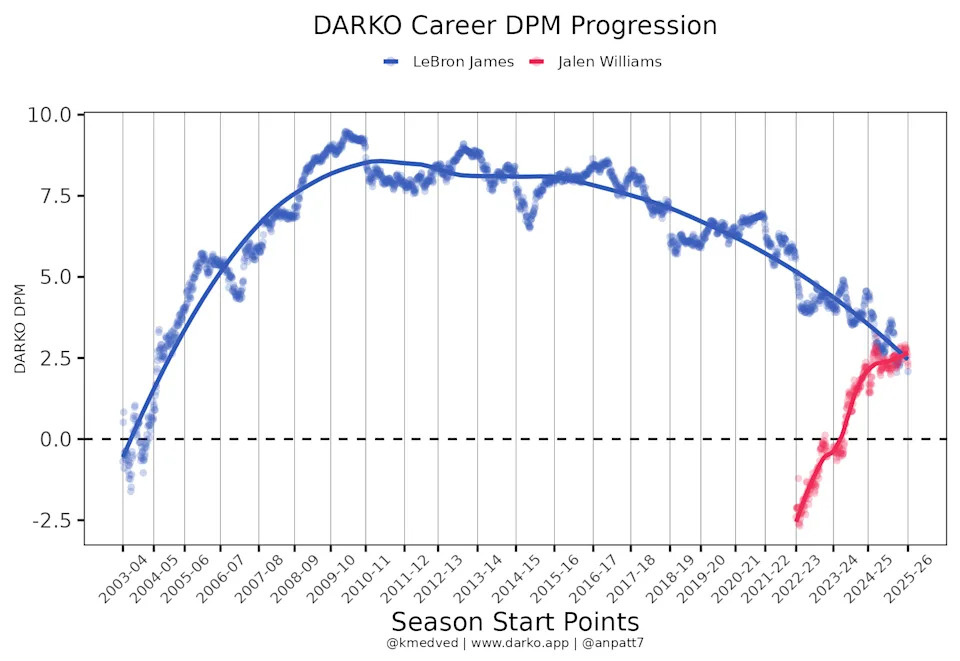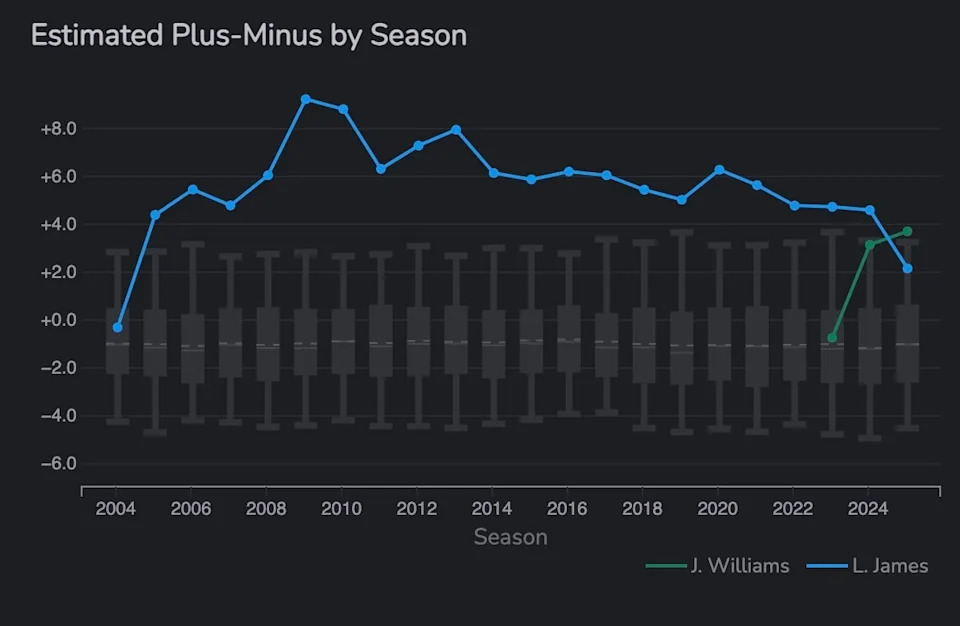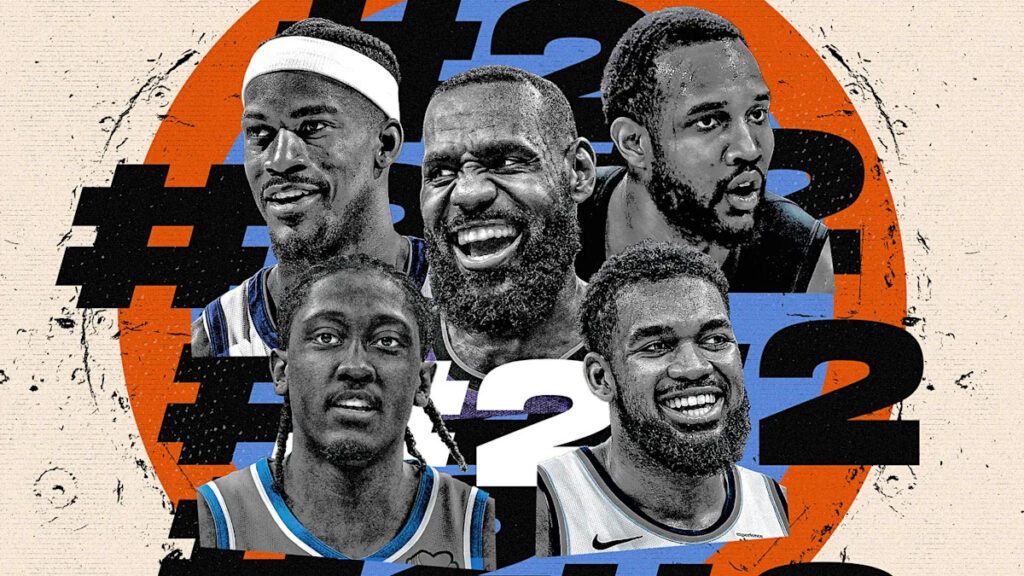Anyone can list the best players in the NBA, but basketball is as much about chemistry as it is talent. Within each of the league’s 30 teams is a hierarchy, and how well each of the five players on the court understands and performs his role within that hierarchy is every bit as important as his individual skill.
While depth was vital to the success of the Thunder and Pacers last season, and we understand coaches often say, “It’s about who closes the game; not who starts it,” the pursuit of a roster’s most cohesive five-man unit is still paramount. Three of last year’s top four starting lineups on our list — the Thunder, Knicks and Timberwolves — reached the conference finals.
Advertisement
In this series, we rank each team’s starters for a broader look across the league. Ideally, a lineup has its superstar, a deferential co-star, a third star who owns his role, a fourth option and a fifth starter to tie it all together — clear Nos. 1, 2, 3, 4 and 5. How close does your team come to an ideal lineup?
(Taylor Wilhelm/Yahoo Sports Illustration)
No. 2 options: The Deferential Co-Stars
What is a No. 2? Here is how we described him last year:
He is, generally, the team’s second option on offense. He can be an All-Star. In fact, he better be one if you want to compete for a title. Maybe his skill level is a hair below his top teammate. Maybe his skill set is more complementary. Or maybe his personality is more obsequious.
Whatever the case, he understands he is not the No. 1, and that is what is most important. Teams do not reach their potential when the No. 2 believes he is the No. 1. All the greats had a Hall of Fame No. 2, and all of them knew where they stood. Bill Russell had Bob Cousy. Michael Jordan had Scottie Pippen. Larry Bird had Kevin McHale. Kareem Abdul-Jabbar had Oscar Robertson, then Magic Johnson, and then Magic flipped it. Shaquille O’Neal had Kobe Bryant, who then had Pau Gasol. It has a way of sorting itself out.
We should add: Defense is a complementary skill! And maybe the most important one among No. 2 options. If a team’s No. 1 is ball-dominant, and he almost always is, then his offensive responsibilities often leave slack to be picked up on the defense end. How a co-star supports his leading man is every bit as important as his athleticism or skill. There is a little more dirty work to be done when you are a second option.
Advertisement
[High Score is a new way to play Fantasy Basketball on Yahoo with simple rosters and scoring. Create or join a league]
What we have to decide here, then, is how to rank these players, by skill or by how well they complement a team’s top dog. Let’s call it a combination of the two, inviting even more subjectivity into this exercise. We ranked every co-star. You can debate us on their merits. And we’ll have fun doing it. How about that?
Lastly, we sourced these lineups and each player’s status within them with beat reporters around the league. We appreciate everyone who casted a roster; there are too many people to thank in this space. And we recognize that not every player listed here will be in an opening-night starting lineup. Injuries occur. Coaches change their minds. But just know that this is our best guess at the rotations we will likely see most often from each team.
On Monday, we ranked the No. 1 options. Without further ado, your five best No. 2s …
1. Jalen Williams, Oklahoma City Thunder
Welcome to our most controversial decision of 2025.
Advertisement
Is Williams a better player than LeBron James right now? There is some question about that. James had the superior traditional statistics last season. He averaged a 24-8-8 to Williams’ 22-5-5, scoring more efficiently, too. This is probably why James appeared on the All-NBA second team, while Williams cracked the third team.
However, Williams surpassed James in several advanced metrics last season, including Daily Plus-Minus:

And Estimated Plus-Minus:

(via Dunks and Threes)
(Dunks and Threes)
This is probably because Williams also made the All-Defensive Second Team as someone who can and did defend all five positions. His impact on both ends of the floor was arguably broader. It easily was in the playoffs, where James’ Lakers were ousted as third-seeded favorites in five games of a first-round series with the Minnesota Timberwolves. Williams, playing on an injured wrist that required offseason surgery, helped the top-seeded Thunder to the title, even scoring 40 points in a pivotal Game 5 of the NBA Finals.
Advertisement
What cannot be argued, really: Williams is the better complementary co-star to Shai Gilgeous-Alexander in Oklahoma City than James is to Luka Dončić in Los Angeles. There is overlap in the ball-dominant skill sets of James and Dončić, and neither helps the other on the defensive end. Meanwhile, Williams is exactly who OKC needs him to be. Sometimes more, rarely less. He can and does do a bit of everything.
If you need everything from James, he might be able to give it to you on any given night. But if you are asking me: Who is the best No. 2 in basketball right now for the entirety of a season, including playoffs? I think you would be better suited to pick a 24-year-old rising co-star of a championship team over a 40-year-old who will miss the start of the season to sciatica, even if that 40-year-old is LeBron Effing James.
2. LeBron James, Los Angeles Lakers
What else is left to say about James? He is unquestionably on the Mount Rushmore of NBA legends, along with Jordan, Abdul-Jabbar and Russell. How you want to order them is your business, but nobody has sustained his greatness for as long as James has. Did we mention he is 40?
Advertisement
Do you know how good you have to be in order to be among the league’s best second options at the age of 40? Your days as an All-NBA performer cannot be behind you. And James has proven, when healthy, he is still one of the league’s 15 best players. Remarkably, he has not missed an All-NBA team since 2004.
This season? It isn’t starting out great. Sciatica will, at the very least, cost James the first week of his 23rd campaign. Any time anyone mentions the phrases “40 years old” and “sciatica” in the same breath, I can feel the pain in my own backside, but this is LeBron James we’re talking about. He’s been a superhuman force for more than two decades, and we’ll not believe Father Time has him beat until the game is called.
That said: There is some question about his fit with Dončić, especially on the defensive end. The Lakers allowed 117 points per 100 possessions whenever James and Dončić were in tandem last season, which would have ranked 26th in the league if averaged over a full season. That weakness was their fatal flaw, and the Lakers did little to address it over the summer, choosing Deandre Ayton as their rim protector.
There is also some question about whether James understands he is the Lakers’ second option. He has never been that in his career — until now — and while he has said all the right things since Los Angeles’ acquisition of Dončić, there is a difference between saying what is necessary to win games and doing it.
3. Evan Mobley, Cleveland Cavaliers
Besides Williams, Mobley was the only other player to crack both the All-NBA and All-Defensive rosters, making the second and first teams, respectively. He was also the league’s Defensive Player of the Year.
Advertisement
The 24-year-old’s traditional statistics — 19-9-3 on 56/37/73 shooting splits — may not jump off the page, but he is capable of everything on a basketball court at nearly 7 feet tall, drawing favorable comparisons to a young Kevin Garnett. Offensively, he is a threat from the perimeter, the post or anywhere between, generating open looks as a scorer, a passer and a screen-setter. On the other end, he can defend all five positions in space or at the rim. He is long and athletic and skilled, all the physical attributes you’d want.
Is he as manically driven toward superstardom as KG was? That is the question, for Cleveland’s prospects as a title team — and not the second-round fodder it has been for the past two seasons — hinge on the development of Mobley. Here is a vote of confidence in his pursuit of an even higher spot on this list.
4. Jimmy Butler, Golden State Warriors
Butler was a No. 1 option for the Miami Heat when last we visited this exercise a year ago and a damn good one at that. He led the Heat to NBA Finals appearances in 2020 and 2023 and demanded a trade last season once it became clear he could no longer reach those heights with their deteriorating roster.
Advertisement
He landed in Golden State, where the Warriors were phenomenal in his brief time on the team. They finished 23-7 down the stretch with him in the lineup, outscoring opponents by double digits per 100 possessions whenever he was on the floor. They ousted the second-seeded Houston Rockets in the first round of the playoffs and only lost in the Western Conference semifinals once Stephen Curry was hurt.
While Butler can still be a bona fide No. 1 if need be, his skill set is perfectly suited to complement any superstar, including Curry. He creates turnovers on defense and does not commit them on offense. Likewise, Butler gets to the free-throw line on offense and does not foul often on defense. He wins possessions, and over the course of a 14-year career that relentlessness has won more games than not.
5. Karl-Anthony Towns, New York Knicks
If only Butler knew how close Towns has drawn to him on this list. Towns was once considered a losing player, perpetually missing the playoffs on the Minnesota Timberwolves. They broke through to the 2024 Western Conference finals with him as their second-best player, supporting Anthony Edwards, only to trade him to New York, where he helped Jalen Brunson’s Knicks to the 2025 Eastern Conference finals.
Advertisement
That’s right: Karl-Anthony Towns, my friends, is a winning basketball player. The Knicks were seven points per 100 meaningful possessions better when he was on the court during the regular season, according to Cleaning the Glass, and even better (+8.7) in the playoffs, ousting the defending champion Boston Celtics.
There is still some concern about whether Towns’ defensive issues — along with those of Brunson — will ultimately set New York’s ceiling below championship level, but the East is as open as it has been in some time. If they are to win it, it will be on the defensive improvement of Towns, but as is he is an All-NBA third-team member who averaged a 24-13-3 last season on 53/42/83 shooting splits. Pretty freaking good.
The honorable mentions
6. De’Aaron Fox, San Antonio Spurs
Advertisement
7. Franz Wagner, Orlando Magic
8. Alperen Şengün, Houston Rockets
9. Jamal Murray, Denver Nuggets
10. Jaren Jackson Jr., Memphis Grizzlies
11. Bam Adebayo, Miami Heat
12. James Harden, LA Clippers
13. Julius Randle, Minnesota Timberwolves
The rest
14. Derrick White, Boston Celtics; 15. Tyrese Maxey, Philadelphia 76ers; 16. Jalen Johnson, Atlanta Hawks; 17. Brandon Ingram, Toronto Raptors; 18. DeMar DeRozan, Sacramento Kings; 19. Trey Murphy III, New Orleans Pelicans; 20. Jalen Green, Phoenix Suns; 21. Myles Turner, Milwaukee Bucks; 22. Michael Porter Jr., Brooklyn Nets; 23. Brandon Miller, Charlotte Hornets; 24. Jaden Ivey, Detroit Pistons; 25. Shaedon Sharpe, Portland Trail Blazers; 26. Bennedict Mathurin, Indiana Pacers; 27. Klay Thompson, Dallas Mavericks; 28. Khris Middleton, Washington Wizards; 29. Matas Buzelis, Chicago Bulls; 30. Ace Bailey, Utah Jazz
Read the full article here



